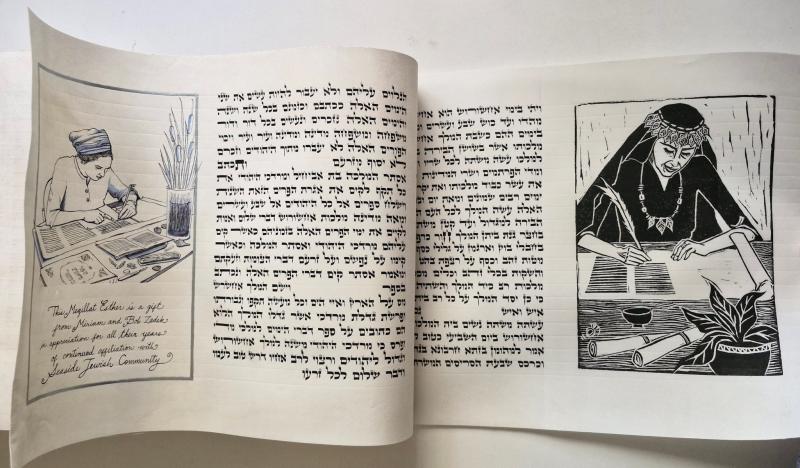Each spring, Jewish congregations celebrate the holiday of Purim, also known as the Feast of Esther, said Rabbi Julie Hilton Danan of Seaside Jewish Community in Rehoboth Beach.
The holiday traditionally is marked by the chanting in Hebrew of the Bible’s story of Queen Esther from a handwritten scroll known as a Megillah, she said. Often, the story, or parts of it, are recounted in English.
This year’s festivities at Seaside were extra special when Danan chanted Queen Esther’s story from a new Megillah that had been handwritten in Hebrew in Israel especially for Seaside.
The Megillah, in time for the holiday, was donated by Seaside founding members, Dr. Bob Zadek and his wife Miriam Zadek, who live in Baltimore. The couple have owned a home in Rehoboth Beach for more than 50 years.
“We donate to Seaside every year,” says Miriam, 96, who has served as a congregation past president and as a fundraising chair over Seaside’s 28-year history. “We learned that a Megillah was something the congregation would like to have.”
Seaside President Lawrence Krevor thanked the Zadeks for the gift and for all their years of generosity and support for coastal Delaware’s first Jewish home.
“The Zadeks have been active Seaside supporters over the years,” he said. “They have been true leaders in our community from the very beginning.”
The Book of Esther, set in ancient Persia, chronicles how a young Jewish woman, Queen Esther, saved her people from destruction, said Danan. The Purim story conveys a message of Jewish survival and resilience in the face of antisemitism and prejudice. At the same time, it’s a joyful celebration full of costumes, humor, noisemakers and special triangle-shaped pastries called hamantaschen.
Seaside’s observance of the holiday included music and noisemakers, as well as costumes and delicious hamantaschen, cakes and pastries and other delights. Observances took place at both the religious school and at an evening service.
“In this digital age, it’s remarkable that Jewish tradition preserves ancient ways of writing sacred scrolls, from the Torah with the Five Books of Moses that we read each week in synagogue, to the mezuzah on our doorposts,” Danan said. “Each sacred scroll is hand-written by a trained scribe using a feather pen, on vellum (parchment), in a style governed by ancient laws and traditions.’’
Rabbi Danan was especially excited to find a female scribe, Israeli Nava Levine-Coren, to write Seaside’s new Megillah. Traditionally, scribing sacred scrolls has been done by men, but today more women are stepping into those roles, particularly for the Megillah, which tells the story of a woman leader.
“The book of ‘Esther’ is one of only two books of the Hebrew Bible named for a woman," said Danan.
“There is a concept in Jewish observance of Hiddur Mitzvah, which means to enhance our spiritual practice by choosing ritual objects that are especially artistic and beautiful,” she said. Danan went on to explain that Seaside’s Megillah is a perfect example. The Hebrew writing is precise and clear. Unlike a Torah, the Megillah can have illustrations. The Seaside Megillah opens with a linocut of Queen Esther writing, perhaps scribing the Purim story as described in Esther 9:29. At the end of the scroll, the scribe included a self-portrait in pen, ink, and watercolor, of herself writing the scroll. Her writing table holds some seashells and vase of cattails as a visual hint that this Megillah was commissioned for Seaside Jewish Community.
“There is something very special about reading our ancient story from a unique and beautiful scroll like this, straight from a female scribe in Jerusalem to our community here in Delaware,” she said.


















































